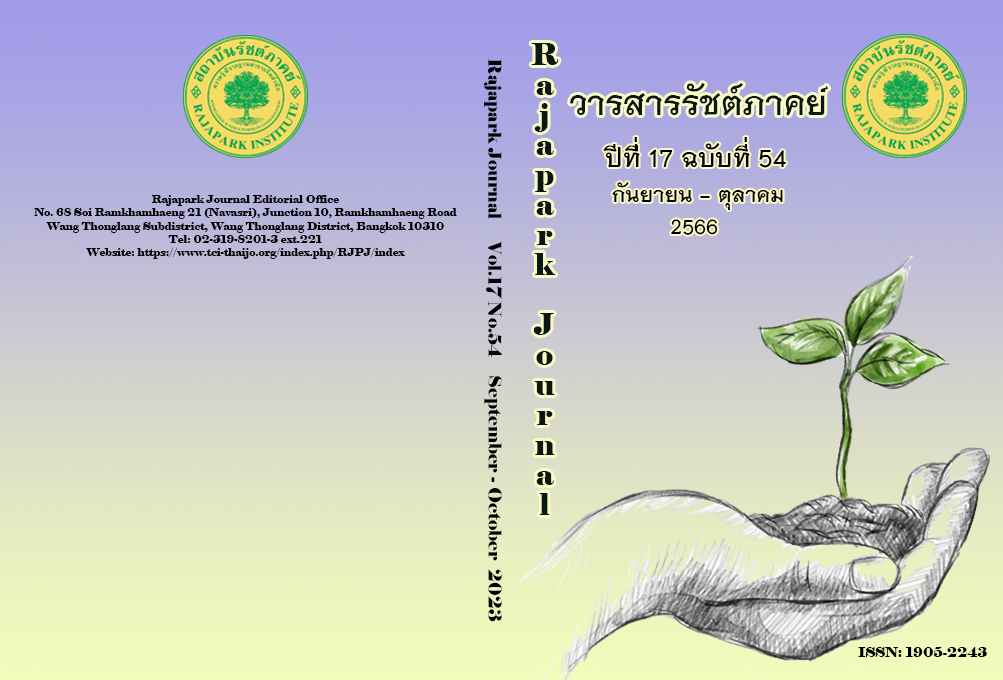การสังเคราะห์รูปแบบองค์กรนวัตกรรมในธุรกิจอุตสาหกรรมขนาดกลางและขนาดย่อม
Main Article Content
บทคัดย่อ
นวัตกรรมมีบทบาทสำคัญอย่างมากในการขับเคลื่อนองค์กร ส่งเสริมให้องค์กรปรับปรุงกระบวนการทำงานให้มีประสิทธิภาพกว่าเดิมนำไปสู่ศักยภาพในการแข่งขันที่สูงขึ้น การวิจัยครั้งนี้มีวัตถุประสงค์เพื่อ 1) ศึกษาโครงสร้างองค์ประกอบของการเป็นองค์กรนวัตกรรมของธุรกิจอุตสาหกรรมขนาดกลางและขนาดย่อมในประเทศไทย 2) ศึกษาปัจจัยสำคัญที่ส่งเสริมการเป็นองค์กรนวัตกรรมของธุรกิจอุตสาหกรรมขนาดกลางและขนาดย่อมในประเทศไทย และ 3) สังเคราะห์รูปแบบองค์กรนวัตกรรมที่เหมาะสมกับธุรกิจอุตสาหกรรมขนาดกลางและขนาดย่อม ผู้จัดทำกำหนดให้การศึกษานี้เป็นการวิเคราะห์อภิมาน (Meta-analysis) โดยใช้การสังเคราะห์งานวิจัยเชิงคุณภาพและปริมาณ ด้วยเก็บข้อมูลจากเอกสารงานวิจัยเชิงคุณภาพหรือเชิงสหสัมพันธ์ที่ศึกษาประเด็นการพัฒนาองค์กรสู่ความเป็นองค์กรนวัตกรรมและเผยแพร่ในฐานข้อมูลผ่านการสืบค้นจากฐานข้อมูลวิทยานิพนธ์และผลงานวิจัยจากสถาบันการศึกษาต่าง ๆ เพื่อทำการวิเคราะห์ข้อมูลใช้การวิเคราะห์เชิงเนื้อหา ตีความ และสร้างข้อสรุปผลการวิจัยในการศึกษานี้ ผลการวิจัยนี้พบว่า องค์กรที่เป็นธุรกิจอุตสาหกรรมขนาดกลางและขนาดย่อมมีโครงสร้างองค์ประกอบที่ประกอบด้วย ยุทธศาสตร์และวิสัยทัศน์ที่ส่งเสริมนวัตกรรม โครงสร้างองค์กรนวัตกรรม วัฒนธรรมและบรรยากาศองค์กรที่ส่งเสริมความคิดสร้างสรรค์ ภาวะผู้นำเชิงนวัตกรรม กระบวนการพัฒนาองค์ความรู้เชิงนวัตกรรม การมีส่วนร่วมในนวัตกรรม และการบริหารจัดการทรัพยากรบุคคลและเครื่องมือต่าง ๆ โดยปัจจัยที่ส่งเสริมการเป็นองค์กรนวัตกรรมของธุรกิจเหล่านี้ประกอบด้วย เทคโนโลยีดิจิทัล การเปลี่ยนแปลงทางธุรกิจเชิงรุก และระบบการทำงานและเรียนรู้ นำมาประยุกต์เป็นรูปแบบองค์กรนวัตกรรมผ่านกระบวนการบริหารองค์กร 4 ขั้นตอน ได้แก่ การวางแผน (Plan) การดำเนินการ (Do) การตรวจสอบประเมิน (Check) และปรับปรุง (Act)
Article Details

This work is licensed under a Creative Commons Attribution-NonCommercial-NoDerivatives 4.0 International License.
ทัศนะและความคิดเห็นที่ปรากฏในวารสาร ถือเป็นความรับผิดชอบของผู้เขียนบทความนั้น และไม่ถือเป็นทัศนะและความรับผิดชอบของกองบรรณาธิการ
References
Akpoviroro, K. S., & Amos, A. O. (2021). Efficacy of Marketing in Innovation Processes. Cimexus, 16(1), 121-130.
Boh, W. F., Evaristo, R., & Ouderkirk, A. (2014). Balancing Breadth and Depth of Expertise for Innovation: A 3M story. Research Policy, 43(2), 349-366.
Boonkua, A., Tuntinakhongul, A., & Tungkunanan, P. (2020). Innovative Organization’s Components in Basic Education Institutions in Thailand. International Journal of Instruction, 13(3), 31-42.
Budcheewan, P. (2016). A Study of the Causal Relationship of Factors Affecting Innovation Organization of Small and Medium Enterprises Entrepreneurs to Create Sustainable Competitive Advantage. Southern Technology Journal, 9(2), 85-98.
Chankrapor, M., & Chienwatanasuk, K. (2019). Creation of an Innovative Organization to Drive Organizational Excellence. Executive Journal, 52-66.
Chutivongse, N., & Gerdsri, N. (2018). Creating an Innovative Organization. Journal of Modelling in Management, 15(1), 50-88.
Detwiler, B. (2015). Innovation Defined: New, Useful, Real and Critical to Long-term Success. https://www.zdnet.com/article/innovation-defined-new-useful-real-and-critical-to-long-term-success/
Farniha, L., Ferreira, J., & Gouveia, B. (2016). Network of Innovation and Competitiveness: A triple Helix case study. Journal of the Knowledge Economy, 7(1), 259-275.
Intaragumnerd, P. (2019). Thailand’s Middle-Income Trap: Firms’ Technological Upgrading and Innovation and Government Policies. Seoul Journal of Economics, 32(1), 107-135.
Mairiang, K. (2020). Innovation Model for Small and Medium Enterprise Business Administration. Journal of Buddhist Social Sciences and Anthropology, 10(2), 255-268.
Mano, P. (2019). The Impact of Digital Disruption to Education. Journal of Industrial Education, 18(1), 1–6.
MReport. (2022). OSMEP Forecasts SME GDP in 2023 to Grow 4.9%. https://www.mreport.co.th/news/economy/337-Forecast-GDP-SME-2023/
Namae, N. (2019). Factors Affecting Innovation Capabilities of Small and Medium Entrepreneurs in Pattani, Yala, and Narathiwat Provinces[Master’s Thesis, Prince of Songkla University].
Namburi, S. (2019). Innovation and Management. Academic Journal, 2(2), 121-134.
Narcizo, R. B., Canen, A. G., & Tammela, I. (2017). A Conceptual Framework to Represent the Theoretical Domain of "Innovation Capability" in Organizations. Journal of Entrepreneurship. Management and Innovation, 13(1), 147-166.
Paladino, A. (2022). Innovation or Entrepreneurship: Which Comes First? Exploring the Implications for Higher Education. Journal of Product Innovation Management, 39, 478-484.
Phakdeelao, W. (2011). A Study of Organizational Characteristics of Innovation: A Case Study of Organizations Awarded for Innovation[Master’s Thesis, National Institute of Development Administration].
Phongsichomphu, W., Na-Takuatoong, O., & Kaemkate, W. (2013). Factors Affecting Learning Organization and Innovative Organization. Academic Services Journal, 24(1), 159-186.
Phuangrod, K., Lerkiatbundit, S., & Aujiraponpan, S. (2017). Factor Affecting Innovativeness of Small and Medium Enterprises in the Five Southern Border Provinces. Kasetsart Journal of Social Sciences, 38(3), 204-211.
Pigott, T. D., & Polanin, J. R. (2020). Methodological Guidance Paper: High-Quality Meta-Analysis in a Systematic Review. Review of Educational Research, 90(1), 24-46.
Ruangpayungsak, P. (2020). Research for the Analysis of Innovative Organization of Subsidiaries Affiliated with Multinational Organizations[Master’s Thesis, Mahidol University].
Sakulphatrada, N., & Putiariyawat, C. (2022). Being an Educational Innovation Organization of Secondary Schools that Received the Quality Award of the Office of the Basic Education Commission. Journal of Management Arts, 6(4), 1844-1861.
Shubina, I., & Kulakli, A. (2020). The Research Patterns of Creativity and Innovation: The Period of 2010-2019. International Journal of Emerging Technologies in Learning (iJET), 15(21). 89-102.
Sledzik, K. (2013). Schumpeter’s View on Innovation and Entrepreneurship. SSRN Electronic Journal, 89-95.
Steiber, A., & Alange, S. (2015). Organizational Innovation: A Comprehensive Model for Catalyzing Organizational Development and Change in A Rapidly Changing World. Triple Helix, 2(1), 1-25. DOI:10.1186/s40604-015-0021-6
Sultana, M. A., & Rahman, N. (2012). Innovative Leadership (People). The Jahangirnagar Journal of Business Studies, 2(1), 37-51.
Thirathanachaikun, K. (2020). Causes and Effects of Being an Innovative Organization of Small and Medium Enterprises in the Service Sector of Thailand. Sripatum University.
Ullah, Z., & Arshad, H. (2009). Impact of Internal Innovation on Firm Performance with Moderating Role of Collaborative Innovation[Master’s Thesis, University of Gavle].

